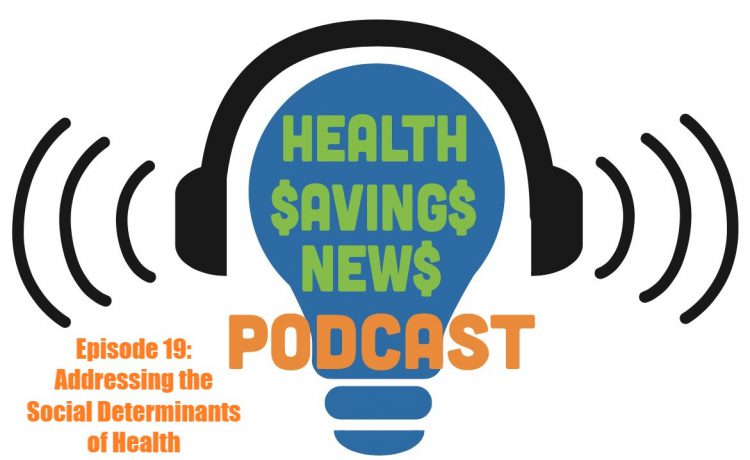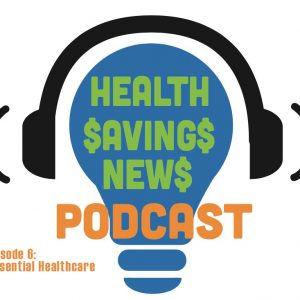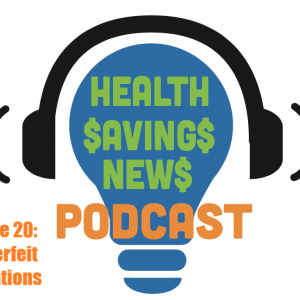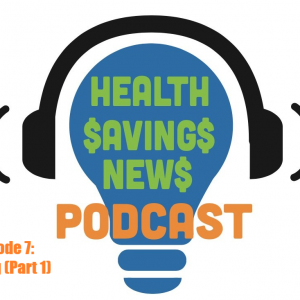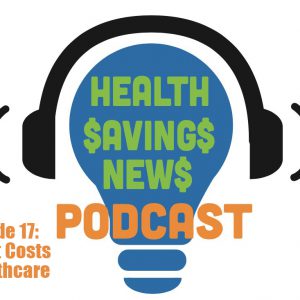Note: This is a rough transcript of episode 19 of Health Savings News and has been lightly edited for clarity. Copy may not be in its final form.
Evan (00:10):
Hello and welcome to Health Savings News, the podcast about healthcare costs in America, and how to save money on the often expensive care all kinds of people need. I’m your host, Evan O’Connor, joined by retired doctors Rich Sagall and Mike Woods. How are you guys doing today?
Mike:
Good.
Rich:
Good, and yourself?
Evan:
I’m doing all right. Each episode we discuss healthcare costs in America, offer our tips for saving money and relevant news that affects and reflects the expensive landscape of healthcare in America. This week’s topic is addressing the social factors that impair health and healthcare. Last episode, we discussed the social determinants of health, and this week we’ll be exploring the ways that exist to address some of these factors. Addressing the factors that impair health and healthcare begins with recognizing the existence and severity of the problem and a determination to do something about it. The solutions will often be very complex and will require a coordinated effort by all involved. The reality is there is little individuals can do to change the conditions that dictate the social determinants of health, but there are things individuals can do to improve their health and healthcare in the current environment. It is worth noting these tasks often require internet or other resources, and some can be challenging — especially if you are experiencing an illness or disability.
That being said: research, be aware of, and take advantage of all the opportunities for assistance such as free health insurance or premium assistance programs; assistance programs for housing, food, clothing, transportation, or other essential needs; family or individual support or counseling programs, career counseling, continuing education programs, judge search assistance. Consider alternative medical care options such as tele-visits or mail order pharmacies. Make an effort to improve health literacy and an understanding of the healthcare system while trying not to be unduly influenced by others. Wear a mask when respiratory illness, including colds, flu, RSV and COVID is peaking in your area, or if you are presenting symptoms of any respiratory illness, and try to reduce your own carbon footprint and support legislation and other organized efforts to combat climate change.
Mike (02:12):
Yeah, as Evan mentioned, this is definitely gonna be a group effort to providing the long-term solutions to the problem, and it needs the effort and cooperation of multiple groups like the healthcare system, local, state and federal governments, health insurance providers, communities, and individual groups within communities, and even private industry — especially those companies that provide their employees with health insurance. The healthcare system, especially individual providers, really need to take their own initiative at this point. Although the many social factors that affect health and healthcare are well known, more research needs to be done to understand how these factors affect health and healthcare and what ways can be used to develop strategies to address them.
Well, some of this work is already being done. A few examples the Association of American Medical Colleges and the dvisory committee on training in primary care medicine and dentistry are currently researching the effect of social determinants on health and healthcare, and using that to create programs that will educate healthcare providers about them and address these issues in their patients. The US Preventive Services Task Force is a very active committee within the government, and it is researched and made many specific recommendation about information providers should seek about the social determinants of health for individual patients. The Agency for Healthcare Research and Quality, which is part of the Health and Human Services Agency, has many studies looking at the various aspects of the problems such as food distribution, community violence, health literacy, and language barriers, age and ethnicity, and the effect of routine screening for social determinants of health. The National Center for Chronic Disease Prevention and Health Promotion is also looking at the problem in collecting evidence to help define what resources that already exist that people can use to alleviate some of these disparities. They have focused on evidence-based interventions that can be expanded in many communities that will advance health equity. They also identify gaps in the evidence and attempt to prioritize research that can create programs to address these gaps and minimize health disparities. Finally, the Department of Health and Human Services has looked at the problem as it relates to Medicare and has offered many recommendations to improve the ability of providers and communities to identify and address social risk factors and integrate health and social services.
The backbone of healthcare is healthcare providers, and they should be making the effort to learn about these factors, ask their individual patients about these factors how they affect them, and to learn about and make efforts to individualize care that addresses their needs. There are many healthcare tools available to providers, and one of the largest ones is, again, the Agency for Health Research and Quality that have created many tools that healthcare providers can use to learn about assessing their patients’ socioeconomic status, how to work with public health and community resources, how to coordinate patient care with their social needs, how to deliver culturally and linguistically competent care, how to deliver health literate care, and encourage health literacy. And finally how to refer patients for social needs such as food or housing. The next are a couple of tools that physicians can use to ask questions about the social determinants of health. Some of them are based on valid research, identifying those needs that do directly affect patients. Some of the programs include Health Begins Upstream: A Risk Screening Tool, Wellrx Screening Tool, Your Current Life Situation Survey from the Kaiser Permanente in California, the protocol for responding to and assessing patient assets, risks, and experiences, and a nonprofit healthcare innovation center that is developing a electronic health based system to collect data about the social determinants of health for individual patients in developing a referral tool that can be used directly from the electronic health record.
The government is a major player in helping to deal with the social determinants of health, and they do offer many good contributions to improving healthcare. Many of these contributions involve legislation, regulation and oversight that can benefit patients. To me, the most important legislation that’s happened in recent years is the Affordable Care Act. Some of the significant benefits that patients have now because of the Affordable Care Act include the outlining of various types of healthcare that people are entitled to, meaning that healthcare providers have to provide at least this level of healthcare for all of their patients. They set limits on healthcare insurance companies including not being able to deny insurance based on preexisting conditions and limiting out of pocket costs that the healthcare insurance companies can have patients pay. They have established a competitive healthcare insurance marketplace for those who can’t obtain healthcare from their employment or other areas. They have provided premium subsidy programs for those with financial hardships, and they have allowed children to stay on their parents’ insurance until they’re 26 years old, allowing them to get a better start in life. Now, the government also has oversight in many areas of healthcare. For instance, the Food and Drug Administration, the Public Health Accreditation Board, and the Government Accountability Office are all responsible for monitoring the quality of medical care, both at the level of individual providers, hospitals, and medical groups. Most state governments are responsible for the licensing of healthcare providers in assuring their qualifications to practice medicine. A lot of medical research is overseen by the government, and the government is significantly involved in public health through many agencies such as the CDC, Department of Health and Human Services, National Institute of Health, the Substance Abuse and Mental Health Services Administration, and the Administration for Families and Children. Finally, the government is also primarily responsible for HIPAA, which is rules that protect the privacy of patient information. The government is also responsible for monitoring and regulating work conditions, the environment, and housing in living conditions. These being OSHA, the Environmental Protection Agency, and the Federal Housing Authority,
Rich (09:51):
There are many assistance programs, both federal, state, and local. Most people are familiar with Medicaid. There’s also a program called CHIP, which is the Children’s Health Insurance Program, both of which provide free medical care for qualified low income individuals and their families. Everyone’s familiar with Medicare, which is a federal health insurance for those 65 and older and younger people with certain disabilities. And there’s also other programs under Medicare. One of them is a Medicare Medicaid Disproportionate Share Hospital payments program, which helps hospitals that see more than their fair share of indigent patients cover the cost for their care. They’re also programs that have financial assistance for low income families, for childcare, improved housing, education, and other areas of social determinants of health, all of which will impact upon their health. NeedyMeds does its part to help with information on many programs that supply free medications, medical equipment. We have programs on camps, scholarships, retreats, copay cards, discount cards, and much more. All that is accessible on the website are by calling a helpline at 1-800-503-6897.
Let’s move on to early intervention programs. The early intervention programs that provide subsidies for pre-K and nursery programs and other such programs that help children get a head start. The government also supports programs in the communities and social programs such as reducing secondhand smoke exposure, limiting environmental emissions and pollutants, paying for environmental cleanups, and work to combat climate change.
Mike (11:40):
As a pediatrician I saw a lot of children who certainly needed early intervention programs, and both from personal experience and research has shown that these children do better not only in school, but in life. So early intervention programs really do improve some of the social determinants of health for the children who are involved in these programs.
There are many programs out there through various agencies that do support patients and healthcare providers addressing the social determinants of health. The National Center for Chronic Disease Prevention and Health Promotion has programs that work with patients from different sectors, such as education, housing, healthcare, community development, or transportation to expand existing programs to improve their ability to address the social determinants of health. This agency also monitors for disparities in service and tries to redistribute funding and provide guidance and technical assistance to bring the services to a more equal basis. The CDCs program closing the gap with social determinants of Health Accelerator Plans funds 36 programs that help accelerate actions in the state, local, and tribal jurisdictions that will help prevent and reduce chronic diseases among people experiencing health disparities. Some of those in programs include the Building or Encouraging Healthy Environment program, which provides resources to improve health equity, overall community health, and people’s behaviors that drive health. The linking community, social service and clinical resources program can it help improve community health by providing screening tools for providers that can be integrated into electronic health records, helping providers through the Planning and Partnerships program, and providing guidance from the National Leadership Academy for the Public’s Health. They’re also programs the Improved Food and Nutrition Security helps to assure access to enough high quality foods to avoid hunger and stay healthy. The Increased Social Connectedness program helps individuals or groups of individuals seek the needed number in quality and diversity of relationships that improve their sense of belonging, value, and that they are cared for and supported. The Center for Medicare and Medicaid Services created the Accountable Health Communities program that helps match the needs of a population with community resources.
Now, one of the areas to focus on is rural areas because rural residents often get less assistance programs because a lot of grants are block grants, meaning that they distribute federal funds based on population and population density , and because most of these programs are designed for urban areas, they are more expensive to spread over larger geographic areas. So the number of programs that exist for rural areas is much less. Current programs include the Rural Integration Models for Parents and Children’s to Thrive program that provides intensive technical assistance to help rural communities create service systems that address the needs of both parents and children, including job training and workforce development for adults, access to early education services for children and mental health and healthy living services for families. The Maternal and Child Health Bureau has home visiting programs in a child poverty telehealth program that enhances traditional services programs in rural areas such as Early Headstart, Headstart Temporary Assistance for Needy Families, and Assets for Independence program. There’s also a guide for rural healthcare leaders that offers a program that educates rural healthcare leaders in teams about strategies and resources to help understand the impact of the social determinants of health on rural patients and communities.
Rich (16:10):
In the past, I served on the board of a regional Area Agency on Aging, and they provided many of the services for elderly people that would fall under this category of social determinants of health. They had people who would go out and take care of pets if they couldn’t get out outside with their dog. They had volunteers who would call periodically just to con just have a conversation with people who were shut in, they had food programs, meals for me, et cetera. So that’s a very valuable resource that people should check out: the Area Agency On Aging,
Mike (16:42):
One of the primary contributors that will be needed to address the social determinants of health are insurance companies. Efforts need to be made by both healthcare insurance companies and government officials to make healthcare insurance more available to those in need, less expensive, and to cover a wider range of healthcare. They also need to incorporate social interventions and to cover medical care. In other words, they need to recognize that the social environment is an important part of medical health that needs to be addressed and paid for by insurance companies. Now, some health insurance companies have already created many programs that do address these issues. These include programs that create or work with companies to specifically address these issues. They provide transportation or home delivery for patients to obtain medication and nutritious meals, that give financial rewards to patients for getting preventive care, recommended screenings, and for any lifestyle changes they are trying to make. There are programs to assist patients in finding and maintaining adequate housing and to improve their neighborhoods and built environment. Some programs provide job training and/or access to educational programs. There are a lot of programs that encourage and help patients improve social interactions. There are many programs that also address loneliness, social isolation at a community level rather than generally. There are programs that connect patients directly to dietary services mainly those with chronic illnesses where diet is an important part of their treatment and help them to get to things such as dietician or nutritionist, a local food pantry or grocery store that offers a discount program through their insurance, and they partnering with mobile food pantries or food delivery services so that good food can be delivered to their homes. Finally, there are programs that can teach self-defense or address violence, especially domestic violence.
Rich (19:00):
One of the problems with all these programs is connecting people to the program and educating healthcare providers about the social determinants of health and the programs that are available. Unfortunately, most insurances don’t cover the work of a social worker so that physicians would not have such a person in their practice. So that’s a real issue that needs to be addressed. We also should talk about communities and individual groups, what they’re doing. Communities need to assure adequate safety for their residents, and this can include more and better trained public safety officials. Community watch programs, more attention to public safety measures such as bike lanes, sidewalks, street signs and lights, community cleanliness and community health workers can be a valuable resource. Communities and individual groups, including school systems, need to find ways to offer and encourage activities such as group activities, improved education and educational opportunities, and career counseling and job training. There need to be the creation of food pantries and nutrition programs, subsidized and low cost housing, financial assistance for heating, clothing and other essential needs, and social family support and mental health services and recovery programs. Private industry has a role in all of this, and they’re beginning to discover that addressing their social determinants of health in the, in the end saves their money. And this is making healthcare insurance available for more employees, improving work conditions, making them less stressful and safer, dealing and reducing pollutants in other toxic emissions, offering opportunities for flexible work schedules to accommodate those with children or other family obligations, onsite childcare and educational encouragement and advancement. As Mike mentioned, transportation is a big problem. It’s estimated that every year about 6 million Americans miss appointments due to transportation issues. This costs a healthcare system of about $150 billion annually. It’s hard to estimate how much unnecessary pain and suffering results from these missed appointments. It’s estimated that 31% of first-time prescriptions are never filled because the patients have no way of getting to the pharmacy to get their medication. All of these problems can be addressed in a number of ways. A transportation benefit is becoming more common in insurance policies. In many states, Medicare and Medicaid plans will cover the costs to and from a doctor’s visit. Uber Health offers a free transportation program that’s being trialed in a number of communities. Many senior health programs provide volunteer drivers to take seniors to healthcare visits. As has been mentioned, housing or the lack of it is a common issue leading to poor health outcomes. More and more communities are finding that when people have adequate housing, the health status improves and the healthcare costs go down.
Mike (22:00):
We can see there there’s is a lot being done by all of the involved parties to deal with the social determinants of health, but unfortunately, we also have a long way to go before everyone understands and learns how to address the programs to the point where it will have a positive impact on our overall health.
Rich (22:23):
A little test that I’ve often done is ask people, how many times has your doctor when prescribing a new medication brought up the issue of can they afford the medication? It’s rare that any doctor has done that, and that’s such a simple social determinant of health that could be addressed, but isn’t.
Evan (22:41):
It is important to recognize that even as we fight for policies that make affordable healthcare accessible to more people, the goal is greater than any one program can win. Achieving the future we want — where all people can access all the care they need — requires reformation of what our political economy values. A study from the American Journal of Public Health found social democratic welfare states, higher public spending, fair trade policies, extensions to compulsory education provision, health and safety policy, improved access to healthcare and high quality affordable housing all have positive impacts on population health. Neoliberal restructuring has been associated with increased health inequities, higher income inequality, and higher mortality.
Rich (23:26):
I think it’s important for this country to realize that healthcare should be a right and not a privilege, and everyone deserves the appropriate healthcare they need.
[segment break]
Evan (23:43):
The last segment of each episode, we suggest some of the culture, art, entertainment, the social causes we’ve been engaged with to each other and our listeners. Very related to the topic of resolving the social determinants of health is a book I’ve read recently called Health Communism by Beatrice Adler-Bolton and Artie Vierkant. Health Communism explicitly discusses the social determinants of health and proposes solidarity with the most vulnerable people to achieve our goal of truly alleviating the social factors that affect healthcare with the overall goal of severing the ties between capital and health. Health Communism is one of the best books I’ve read over the past year and the authors Beatrice Adler-Bolton and Artie Vierkant also host the podcast called Death Panel with Phil Rocco, Jules Gill-Peterson and Abby Cartus.
Thank you so much for joining us for this episode of Health Savings News. Please subscribe, rate, and review us on Apple Podcast or wherever you’re listening to the show — it really does help. You can follow @NeedyMeds on Facebook, Instagram, LinkedIn, YouTube, Mastodon, and you can follow @HealthSavingPod on Twitter (for as long as Twitter remains around) for updates specific to this podcast and send questions, comments, and topic suggestions to podcast@needymeds.org. Our music is composed by Samuel Rulon Miller. His music can be found at musicisadirtyword.bandcamp.com. The Health Savings News podcast is produced by me, Evan O’Connor. All the sources we use in our research can be found in this episode’s podcast description on our website or your podcast of choice. Health Savings News is not intended to substitute professional medical, financial, or legal advice. Always seek the advice of a qualified healthcare professional or appropriate professional. With any questions, view, express and Health Savings News are solely those of the individual expressing them. Any views expressed do not necessarily represent the views of Health Savings News, other contributors, the NeedyMeds organization or staff. Thanks again for listening. We’ll see you in two weeks with our next episode.
Sources:
https://ajph.aphapublications.org/doi/10.2105/AJPH.2019.305001
https://jamanetwork.com/journals/jamanetworkopen/fullarticle/2798905
https://www.acpjournals.org/doi/full/10.7326/M20-0730
https://www.ahrq.gov/sdoh/health-systems-research.html
https://www.ahrq.gov/sdoh/practice-improvement.html
https://www.aamc.org/system/files/c/2/442878-chahandout1.pdf
https://www.jabfm.org/content/29/3/414
https://sirenetwork.ucsf.edu/tools-resources/resources/your-current-life-situation-survey
http://www.nachc.org/wp-content/uploads/2016/09/PRAPARE_Abstract_Sept_2016.pdf
https://www.ncbi.nlm.nih.gov/pmc/articles/PMC5618800/pdf/nihms906626.pdf
https://www.hrsa.gov/sites/default/files/hrsa/advisory-committees/rural/2017-social-determinants.pdf
https://www.hrsa.gov/sites/default/files/hrsa/advisory-committees/rural/2015-child-poverty.pdf

